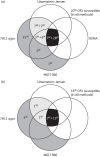Correlation of different phenotypic drug susceptibility testing methods for four fluoroquinolones in Mycobacterium tuberculosis
- PMID: 26851609
- PMCID: PMC4830418
- DOI: 10.1093/jac/dkv499
Correlation of different phenotypic drug susceptibility testing methods for four fluoroquinolones in Mycobacterium tuberculosis
Abstract
Background: Molecular resistance testing fails to explain all fluoroquinolone resistance, with a continued need for a suitable rapid phenotypic drug susceptibility testing method.
Objective: To evaluate the optimal method for phenotypic fluoroquinolone susceptibility testing.
Methods: Using Löwenstein-Jensen medium, Middlebrook 7H11 agar, BACTEC-MGIT 960 and the resazurin microtitre plate assay, we determined susceptibility to fluoroquinolones in Mycobacterium tuberculosis and investigated cross-resistance between ofloxacin, levofloxacin, moxifloxacin and gatifloxacin. We compared MICs of all four fluoroquinolones for 91 strains on Löwenstein-Jensen (as the gold standard) with their MICs in resazurin plates, and with ofloxacin susceptibility at a single concentration in MGIT and on 7H11 agar, in addition to sequencing of the gyrAB genes.
Results and conclusions: Applying a cut-off of 2 mg/L ofloxacin, 1 mg/L levofloxacin and 0.5 mg/L moxifloxacin and gatifloxacin in all methods, some discordance between solid medium and MGIT methods was observed, yet this tended to be explained by MICs around the cut-off. The high discordance between Löwenstein-Jensen (LJ) and resazurin plates suggests that the currently applied cut-offs for all fluoroquinolones in the resazurin method should decrease and minor changes in colour (from blue to purple) be considered as meaningful. High-level resistance in all assays to all drugs correlated well with the presence of gyrA mutations, in support of recent findings that fluoroquinolone resistance should be tested at different concentrations, as patients with lower levels of resistance may continue to benefit from high-dose fluoroquinolone-based therapy.
© The Author 2016. Published by Oxford University Press on behalf of the British Society for Antimicrobial Chemotherapy.
Figures




References
-
- World Health Organization. Global Tuberculosis Report 2014. WHO/HTM/TB/2014.08. http://www.who.int/tb/publications/global_report/gtbr14_main_text.pdf.
-
- Aung KJM, Van Deun A, Declercq E et al. Successful ‘9-month Bangladesh regimen’ for multidrug-resistant tuberculosis among over 500 consecutive patients. Int J Tuberc Lung Dis 2014; 18: 1180–7. - PubMed
-
- Van Deun A, Aung KJM, Halim MA et al. Short, highly effective, and inexpensive standardized treatment of multidrug-resistant tuberculosis. Am J Respir Crit Care Med 2010; 182: 684–92. - PubMed
-
- Jo KW, Lee SD, Kim WS et al. Treatment outcomes and moxifloxacin susceptibility in ofloxacin-resistant multidrug-resistant tuberculosis. Int J Tuberc Lung Dis 2014; 18: 39–43. - PubMed
Publication types
MeSH terms
Substances
LinkOut - more resources
Full Text Sources
Other Literature Sources
Molecular Biology Databases

